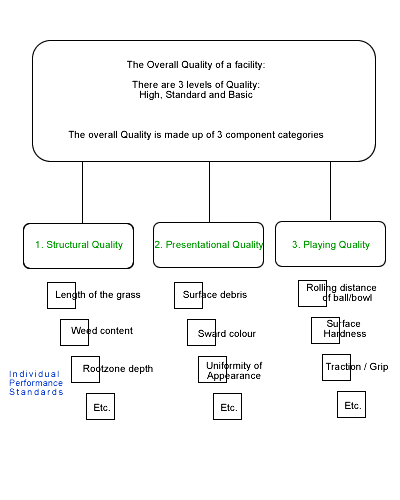Introduction
Good groundsmanship and turf management skills contribute to the production of quality sports and amenity surfaces, making the best use of the available resources.
To help a groundsman or turf manager decide how to make the best use of these resources, the IOG has a range of detailed guidelines that identify what needs to be achieved for these surfaces. These guidelines, which have pulled together available knowledge, are contained within the 'Performance Quality Standards' framework and describe what the product (for example a cricket pitch) will consist of.

This framework provides not only a focus for discussion to gain a consensus of agreement, but more importantly it can be readily incorporated into existing maintenance programmes and used by all groundsmen and turf managers to produce a football pitch, bowling green, ornamental lawn etc. that meets national standards.
Structural Quality
This looks at both surface and subsurface criteria and is the physical make-up of an area. There are about twenty criteria and they include, for example,
- an appropriate range for the length of grass and herbage;
- an appropriate figure for the amount of bare areas present;
- the maximum amount of annual meadow grass content that is consistent with the different levels of quality;
- a desirable grass content; this encourages the groundsman to determine what is a desirable grass for their particular surface;
- a pH range for appropriate grass growth;
- an appropriate figure for the amount of weed content within the turf, etc.
Presentational Quality
This is the visual look of the surface and is often the main factor that a layman will offer an opinion on. Comments such as 'The turf looks nice and green, therefore it must be good' are common from the layman: All groundsmen know that there is an awful lot more to produce good pitches than just the colour.
There are less criteria within this category, however, they help to define what is meant by the presentation of a surface, for example,
- the appearance of the surface of the turf considers how clean is the cut or is there any ribbing on the grass?
- for football and rugby - how well aligned are the goal posts?
- how much surface debris is present?
- how clear are the pitch line markings?
- how uniform is the colour of the turf? etc.
Playing Quality
This category considers what a player experiences on a pitch and includes examples such as
- how far the ball rolls;
- how hard the surface is;
- the amount of surface traction (grip) provided by the turf;
- the disintegration of the surface ('minefielding' on a cricket pitch); etc.
By putting together all of these different criteria the IOG have produced a comprehensive picture of a particular sports or amenity surface. The framework concept can also be readily adapted to any facility.
